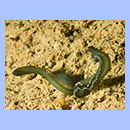- Kingdom: Animalia
- Phylum: Echiura
- Norwegian: pølseormer
Characteristics:
Many echiurans live in crevices or buried in sand or mud. Occasionally the elongated, sheet-like mouth (proboscis) can be seen stretched out on the bottom. It is not unusual that the mouth is longer than the rest of the body. A digestive channel runs in full body length to the posterior end. The spoon worms absorb oxygen through the skin. They usually feed on deposits on the seabed.
In many cases, you will only encounter the females, as the males are of microscopic size and live inside the females. Larvae touching the skin of an adult female turn into males. For some echiurans the male has never been found.

